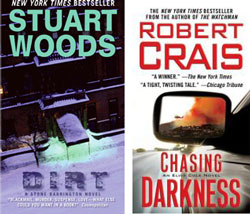
Books: Stuart Woods and Robert Crais
Documentary: Food Inc.

I highly recommend this 2008 documentary. It looks at how aspects of the food industry control what we eat with little concern for its affect on our health or the humane treatment of animals. The film touches on big monopolistic companies like Tyson and Monsanto, examines the world of organic farming, gives glimpses into factory farming, and shows how big food companies carry the same political cloud as the oil, gun, and other lobbies.
This is a documentary where you learn a lot. Here are some things I gleaned:
- We re-engineered the chicken to grow in 49 days, instead of 70.
They now have very large breasts, because people prefer white meat. - The
hamburger you buy in the store may come from hundreds of different cows
slaughtered on factory farms, and there’s a chance that one of those
cows had e coli. This scary argument is presented very convincingly. - In both Republican and Democratic administrations, key position
involved with food regulation and policy are filled by people who once
worked for the food industry–lobbyists, corporate board members,
lawyers, etc. You won’t find ordinary farmers in any position of
influence. - Why can you get a hamburger for a dollar, but you can’ get a head of broccoli for a dollar? It’s because we’ve skewed what we subsidize to the bad calories.
- From an evolutionary standpoint, our bodies are not wired for sugar, salt, and fat. But those dominate our diets.
- God designed cows to eat grass. That’s how their digestive system works best. But most of the beef we buy is corn-fed. The goal is to bulk up cattle quickly. But for corn-fed cattle, you must grow the corn, transport it, then remove the manure–all of which are not environmentally friendly practices. Grass-fed cows, by comparison, graze on the grass and their manure fertilizes it. It’s a complete system in one field, and it saves on gas and transportation costs.
- Most Mexican farmers grew corn. NAFTA flooded Mexico with cheap American corn, and put 1.5 million Mexican farmers out of work.
- The film blasts Monsanto to pieces. Monsanto basically owns everything involving soybeans because they patented a gene in the soybean. Farmers can’t fight them. Monsanto has a big team of investigators who go after farmers in court.
- Wal-Mart was commended for some of their practices and their embrace of organic foods.
- The food industry fights any kind of food labeling requirements. They don’t want you to know what’s in your food, how it was grown, and where.
- The film suggests that the battle against tobacco is the model for how an industry’s irresponsible behavior can be changed.
- Companies that don’t treat animals with respect probably don’t treat workers and the environment–and customers–with respect.
- Buy locally grown food. It doesn’t need to be transported long distances (more eco-friendly), and it probably doesn’t come from factory farms, where animals are warehoused in squalid conditions until they are ready for slaughter.
Religious Diversity on the Supreme Court
Pat Buchanan stirred up some controversy by objecting to the idea of having 3 Jews on the Supreme Court. Elena Kagan would join Stephen Breyer and Ruth Bader Ginsburg. If diversity is desired, why have Jews, who comprise 2% of the US population, control 33% of the seats on the Supreme Court?
I’m not sure what I think of that. Processing.
Buchanan points out that of the last 7 justices nominated by Democrats, going back to Kennedy, 1 was black (Marshall), 1 was Puerto Rican (Sotomayor), and the other five were Jews (Goldberg, Fortas, Ginsberg, Breyer, and now Kagan).
Hmmmm. Buchanan regularly stands up for the persecuted American male WASP. He’s not a crazy man for doing so. But it’s sure not politically correct. Which is his point.
The current court has six Catholics, 1 Protestant, and 2 Jews.
- John Roberts–Catholic
- Stephen G. Breyer–Jewish
- Ruth Bader Ginsburg–Jewish
- Anthony M. Kennedy–Catholic
- Antonin Scalia–Catholic
- John Paul Stevens–Protestant
- Clarence Thomas–Catholic
- Samuel Alito–Catholic
- Sonya Sotomayor–Catholic
Do we need that many Catholics? How about an evangelical? Someone who represents me. If not an evangelical, I’ll settle for a Mormon (who make up almost as much of the population as Jews). George Bush could have gone for an evangelical. Instead, he took the Path of Least Resistance by settling for two while male Catholics. Boring!
It’s hard to determine how large the evangelical population is, because we get lumped in with all-purpose Protestants. But evangelicals make up at least 20% of the population. Would it be impossible to confirm an evangelical to the Supreme Court, because of the pro-life stand which almost inevitably accompanies the label? (Doesn’t seem to stop Catholics from getting confirmed.)
I find it interesting that David Souter, one of the 4 (out of 111) Justices who was unmarried, was replaced by an unmarried woman. Souter never married; Sotomayor is divorced. “Unmarried” is a demographic group.
For that matter, at least 10% of Americans claim no religious affiliation; a growing chunk are atheists. Should they have a voice? It might be harder to confirm an atheist than an evangelical.
I’m not sure what I think of all of this, and whether demographic diversity should be the goal when it comes to the Supreme Court. Above all, I want qualified, sharp people. I liked adding a female Hispanic, though it didn’t need to be Sotomayor. I like the idea of adding yet another woman, though it doesn’t need to be Kagan. How about a woman who is an evangelical?
Just throwing out some evolving thoughts.
Steve Jobs for President (of the USA)
 Pundit/comedian Bill Maher says Apple CEO Steve Jobs would do a better job of running America than the Obama administration.
Pundit/comedian Bill Maher says Apple CEO Steve Jobs would do a better job of running America than the Obama administration.
“America needs to focus on getting Jobs — Steve Jobs. Because something tells me that Apple would have come up with a better idea for stopping an oil spill in the Gulf of Mexico than putting a giant box on top of it.
“In 2001, Apple reinvented the record player. In 2007, the phone. This year, the computer. I say, for 2011, we let them take a crack at America. Our infrastructure, our business model, our institutions. Get rid of the stuff that’s not working, replace it with something that does. For example, goodbye US Senate — Hello Genius Bar! So good luck, Steve — you’ll need it!”
Anchor: Cleaning Up Our Neighborhood


Yesterday (May 15), 17 people from Anchor helped clean out the alley behind our church. It was part of the city-wide Great America Cleanup.
We kept two pickups going up and down the alley, one being my Dodge Dakota. Once filled with stuff–mostly leaves and branches–we drove to the church and dumped it all in the church parking lot. The city will come by and pick it up…eventually. Maybe. If they get around to it.
Since I had knee surgery last week, I just drove the truck. None of the grueling work. Didn’t want to push it (though I did anyway, mostly in unloading the truck, and iced my knee once I got home).
Everyone else worked real hard. It was a fun time. We started at 8:30, and by 11:00 had gone the entire length of the alley. The place looks great.
The Messy, Messy Cost of Oil
 “Drill, baby, drill” made a sure-fire applause line during the Republican Convention. But now we’re seeing one side effect of off-shore drilling. Because of our addiction to oil, and our official pampering of Big Oil, the fishing, tourist, and other industries on the Gulf Cost are suffering big-time.
“Drill, baby, drill” made a sure-fire applause line during the Republican Convention. But now we’re seeing one side effect of off-shore drilling. Because of our addiction to oil, and our official pampering of Big Oil, the fishing, tourist, and other industries on the Gulf Cost are suffering big-time.
Accidents do happen. This oil spill, the Exxon Valdez–those are aberrations, accidents that only rarely occur. But when they do occur, they wreak havoc.
The answer, of course, is to develop alternative energy sources. We wasted eight years under George Bush, whose policies always, ALWAYS, did the bidding of Big Oil. He did zippo on the energy front. And if Republicans regain control of the White House, the oil industry will once again get everything it wants.
For energy reform, we unfortunately must depend on Democrats. Scary, but true. I hate the idea of having to depend on Democrats for anything (or Republicans, for that matter), but it’s true.
The current BusinessWeek tells about all the excess energy Germany has from wind power, which generates 8% of the country’s electricity (compared to 1% in the US). During the past eight years, German doubled its wind-power capacity, while the US twiddled its thumbs and kept bowing to Big Oil. Germany’s problem is figuring out how to store the excess electricity. the Scandinavian countries have pushed big into wind power, too.
I wish Obama would start pushing nuclear power, which seems like the best longterm solution. It’s clean, dependable, safe, doesn’t hurt the environment. Of course, if we had a Chernobyl meltdown, I’d be writing something different. But for now, I’m sticking to nuclear power.
Under Obama, we are at least talking about Green Energy on a number of fronts–wind, solar, electric cars, a more efficient power grid etc. We need to get some things going strongly before the Republicans regain control and default back to blowing wet kisses to Big Oil.
“Drill, baby, drill” is not the answer. It’s a finite resource which will run out someday, and squeezing the last drops out of the oceans and ground will get increasingly costly, messy, and dangerous. This oil spill won’t be the last.
Years down the road, the Last Man Standing with coveted oil reserves will be Arabs or Iranians. We’ve gotta stop being in their debt.
1 CommentBooks: MacDonald’s “Galton Case” and “Black Money”
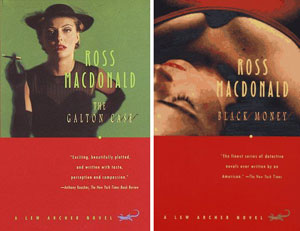
MacDonald wrote 18 Archer books 1949-1976 (he died in 1983).
I’d read five MacDonald books, but still had two on my shelf (all rescued from used bookstores). Henning Mankell’s “The Pyramid” was the 100th book I’d read from the Black Lizard imprint. I decided to start the next 100 with those two Lew Archer books. I read them both during a three-day period while recovering from surgery.
“The Galton Case” is by far the best Lew Archer book I’ve read. An aging wealthy woman hires Archer to find her son, who disappeared 20 years before along with his streetwise bride. That part is solved in fairly short order. But by then the book has become a murder mystery, Nevada gangsters have shown themselves, an old murder surfaces, an apparent grandson appears, and…well, it just keeps getting more and more interesting. The plot takes Archer to Ontario a couple times. This was a highly satisfying book. It totally surprised me, and that’s not easy to do.
I then moved on to “Black Money.” A rich young fellow hires Archer to learn the identity of a suave guy known simply as “the Frenchman,” who has wooed away his girlfriend. Much of the book involves untangling the Frenchman’s identity. But mixed in is a seven-year-old suicide, gambling debts, money laundering, and a bunch of rich people.
MacDonald’s books are rollercoasters. There is no down time, no time for reflection, no private interlude with a girlfriend, no nice meal. It’s all plot. When Archer needs to get from San Francisco to Ontario, it takes a paragraph. You don’t read anything about the journey. He’s just gets on a plane, and a couple sentences later he’s knocking on a door. You really need to concentrate, because there is no chance to catch your breath. MacDonald is well worth the ride.
Movies We’ve Been Watching
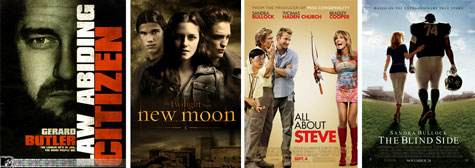 Here are some movies Pam and I have watched recently on DVD. Haven’t been to a theater all year…yet.
Here are some movies Pam and I have watched recently on DVD. Haven’t been to a theater all year…yet.
- “Law Abiding Citizen,” with Gerard Butler (of “300” fame), was a lot better than I expected. Butler’s wife and daughter are brutally killed in a home invasion, and he later exacts horrific revenge. That’s not giving anything away. The rest of the movie is a cat-and-mouse game with police, and it all comes to a surprising conclusion.
- “Twilight: New Moon” is the second movie of the Twilight series. Pam and I liked the first movie, and we liked this one just as well. Vampires dominated the first movie; now we have werewolves. The movies are well-done, and have a definite tone to them. They are not high-action movies, but romances with a, uh, bite.
- We also watched all six of the Jesse Stone TV movies, starring Tom Selleck–5 on DVD, and the latest this past Sunday night on CBS. These are based on the books by Robert Parker. Parker started this series around 1998. We loved these movies. If you watch a movie and then read a Jesse Stone book, you can picture Selleck in every scene and saying every line. He plays Jesse Stone perfectly. Like the Twilight movies, they have a slow-paced, smalltown mood.
- Having watched the Jesse Stone movies, we decided to try the Spenser movies made in the 1980s. “Ceremony” is the first one. I liked Robert Urich in the title role, was okay with Avery Brooks as Hawk, but didn’t like the gal who played Susan. She just wasn’t Susan. I didn’t particularly care for this movie, and it had a lot of gratuitous nudity. But we’ll try another one.
- “All About Steve” is a Sandra Bullock movie, and who doesn’t like Sandra Bullock? In this movie, she plays a very quirky character who pretty much stalks a guy. It’s a fun, light-weight movie.
- Finally, “Blindside,” the movie which won Sandra Bullock an Oscar. This was a great story, an inspiring story. This family took a huge step in adopting a basically homeless young black man into their family…but they changed his life. Now I know why everyone has raved about this film.
Book: The Girl Who Played with Fire
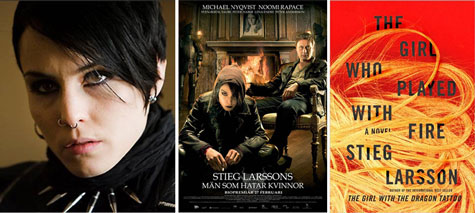
L-r: Lisbeth Salander, as played by Swedish actress Noomi Papace in the movies; a movie poster (picturing Salander and Mikael Blomkvist); the American publication.
I just finished the Black Lizard publication of “The Girl Who Played with Fire,” an amazing book. It’s the sequel to Stieg Larsson’s “The Girl with the Dragon Tattoo,” which stormed the US (and Europe before that) in 2009 (which I reviewed in December 2009). They are the two best mysteries/thrillers I’ve read in a long while.
A third book in the series, “The Girl Who Kicked the Hornet’s Nest,” was published in hardback in the US in May 2010. The three books are known as the Millennium Trilogy.
 Stieg Larsson (right), a Swede, turned in all three books to a publisher in 2004, and the first book (called “Men Who Hate Women” in Sweden) had just been published…and then he died of a massive heart attack. He was 50. Since he and his companion of 32 years, Eva, never married, the entire estate went to Larsson’s father and brother; she got nothing. This is a big scandal in Sweden, though their laws are pretty clear. A case of bad planning.
Stieg Larsson (right), a Swede, turned in all three books to a publisher in 2004, and the first book (called “Men Who Hate Women” in Sweden) had just been published…and then he died of a massive heart attack. He was 50. Since he and his companion of 32 years, Eva, never married, the entire estate went to Larsson’s father and brother; she got nothing. This is a big scandal in Sweden, though their laws are pretty clear. A case of bad planning.
They had no idea these books would become a worldwide sensation. The three books became the number 1, 2, and 3 bestsellers in Sweden, and the same pattern repeated in other countries. In 2008, Larsson was the second-highest-selling author in the world. In 2009, all three books were released as movies in Sweden. To date, 27 million copies have been sold in 40 countries.
The title character, Lisbeth Salander, may be the most interesting heroine you’ll ever read about.
To envision Lisbeth Salander, start with the goth stereotype–black clothes, piercings, tattoos, anti-social, introverted. She’s 4-foot-9 inches tall and weighs 90 pounds. Add a severely dysfunctional childhood and a total distrust of “the system,” which has let her down repeatedly. Then add genius qualities–an expert computer hacker, photographic memory, amazing resourcefulness. And a willingness to resort to violence when threatened.
She is joined by Mikael Blomkvist, a middle-aged investigative journalist with the magazine “Millennium,” thus the title of the series. Blomkvist is well-known in Sweden for his exposes. He and Salander have a strange relationship, mainly because she distrusts everyone and is emotionally bankrupt. They are not a “couple,” but end up working together.
 “The Girl Who Played with Fire” starts pretty much where “The Girl with the Dragon Tattoo” left off, though it mostly occurs two years later. It starts with an upcoming, blockbuster Millennium expose of sex trafficking, but turns into a murder mystery, and then gets taken over by plotlines from “Dragon Tattoo.” Halfway through the book, Salander disappears entirely for a long period as a full-fledged police investigation begins, and Larsson acquaints us with the persons on the police team.
“The Girl Who Played with Fire” starts pretty much where “The Girl with the Dragon Tattoo” left off, though it mostly occurs two years later. It starts with an upcoming, blockbuster Millennium expose of sex trafficking, but turns into a murder mystery, and then gets taken over by plotlines from “Dragon Tattoo.” Halfway through the book, Salander disappears entirely for a long period as a full-fledged police investigation begins, and Larsson acquaints us with the persons on the police team.
It’s difficult to figure out where the book is going, but you can’t pull yourself away. I was sucked in, and just had to keep reading, utterly hooked. Larsson jumps from one character to the next, a few paragraphs or a few pages with each, juggling a host of different perspectives, motives, and agendas. But everything comes together in the end. The plot is very complicated, yet easy to follow. A lot happens in those 630 pages.
Larsson wrote the books in his spare time. His main preoccupation was running an organization that documented and exposed right-wing extremism and racial and religious intolerance. He and Eva lived their last 15 years under death threats from extremist groups, and the threats were real. One reason they never married is that Swedish law requires that married couples make public an address; for security reasons, Stiegg and Eva kept their lives out of the public view.
The third book, “The Girl Who Kicked the Hornet’s Nest,” start immediately where “The Girl Who Played with Fire” ends. I’m anxious to see where the story goes, and may not have the patience to wait for the Black Lizard paperback version in 2011.
Larsson envisioned a ten-book series. Eva still has possession of an unfinished manuscript for the fourth book, and I read that he left a synopsis for books 5 and 6. But his books are so unique, I can’t imagine turning them over to some other writer. Larsson is gone, and I greatly doubt he can be replaced.
Book: “Eight Lives Down”
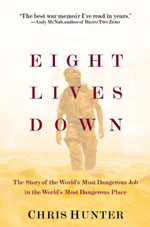 “Eight Lives Down,” by Chris Hunter, is the reality version of “The Hurt Locker,” the 2009 Oscar winning film. The subtitle says, “The Story of the World’s Most Dangerous Job in the World’s Most Dangerous Place.”
“Eight Lives Down,” by Chris Hunter, is the reality version of “The Hurt Locker,” the 2009 Oscar winning film. The subtitle says, “The Story of the World’s Most Dangerous Job in the World’s Most Dangerous Place.”
The author, a British major, spent four months in Iraq in 2004 as a bomb tech–or, more correctly, an ATO: Ammunition Technical Officer. He was already an expert in this field, having served previously in the Balkans, Northern Ireland, Columbia, and elsewhere. When there was an IED or a car bomb, he was called out to diffuse it. The title alludes to the 9 lives of a cat. Considering his ultra-dangerous work, Hunter figures he had one life left.
In two months’ time, Hunter responded to 45 bomb incidents. He was so good at his job that the insurgents put a price on his head, and began designing bombs with the sole purpose of killing him when he responded. For that reason, his superiors pulled him from field duty and gave him a job looking for the bomb makers, using forensic and other evidence. Before he left Iraq, the two main bomb-making groups in Basra had been eliminated.
Hunter tells a number of stories of diffusing bombs. The bombs keep growing in sophistication, thanks to the Iranians. Early on, he and his squad of seven other men were caught in a terrible ambush and fought their way out of it. Hunter is good at making you feel like you’re there.
 I’ve read several books about our current two wars, but this is the first one from a non-American perspective. It was interesting seeing how British troops behave and interact with each other–not much different from American troops, except perhaps a bit more straight-laced. They are certainly highly trained warriors.
I’ve read several books about our current two wars, but this is the first one from a non-American perspective. It was interesting seeing how British troops behave and interact with each other–not much different from American troops, except perhaps a bit more straight-laced. They are certainly highly trained warriors.
And what a sense of humor! Here are some quotes from the book:
- “When you make something idiot proof, someone just makes a better idiot.”
- From helicopter gunship operators: “You can run, but you’ll just die tired.”
- “Those who live by the sword get shot by guns.”
It was also fun wading through all the British jargon: beezer, bollocks, judder, bumf, gobsmacked, biff, blokes, recce. Notice how many of them start with the letter “b.” Either the British like “b” words, or we Americans just don’t like incorporating “b” words from other languages.
Here’s a story. Hunter and three Americans are watching a live feed from an unmanned drone. About five persons are preparing what looks to be a car bomb. Suddenly there’s a flash, and when the picture returns, there’s only a black cloud where the car once stood. “They got love from above,” said one American.
While in Baghdad, heading to the airport, Hunter watches a car pull out of traffic, barrel through street-side shops and pedestrians, and then blow up–a horrific car bomb. The dead and maimed are everywhere. Hunter watches a young woman retrieve her father’s severed hand from atop a vehicle.
They learn that the Iraqi police had captured two bomb-makers. Hunter and Lisa, a British captain, march into the Basra police headquarters, where prisoners are being openly tortured. They barge into a room where the two bombers are being tortured and demand custody of them. The police chief objects, but the woman puts the guy in his place. In that society, the police chief probable had to go kill some prisoners to restore his honor. They walk out of the headquarters with their two prisoners, who then divulge everything they know.
A number of superb books are being written about the Iraq and Afghanistan wars. “Eight Lives Down” is among them, a most fascinating book. It’s not in the league of “Joker One” or “The Forever War” or “Moment of Truth in Iraq,” but it does give two unique perspectives–the British, and the harrowing role of bomb techs.






